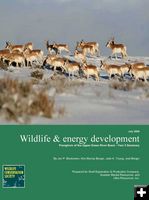Key pronghorn research findings
by Cat Urbigkit, Pinedale Online!
March 15, 2009
The third-year research results of the pronghorn energy development study are now in hand. The research was performed by members of the Wildlife Conservation Society for Shell E&P, Questar and Ultra.
Here are the key (but preliminary) findings to date:
• "As we also noted in our 2006 report, pronghorn do not use habitat within the gas fields uniformly. Within the Pinedale Anticline Project Area (PAPA), pronghorn rely disproportionately on habitat in the vicinity of the New Fork River relative to outlying areas, and depend on specific parcels of federal and state land to facilitate major movements between summer and winter ranges. Some of the preferred habitat near the New Fork River is included in the potential development areas where the Anticline operators and state cooperators proposes to concentrate future gas field development (BLM 2006, 2007).
• "Continuing construction of well pads and roads in the PAPA and Jonah Field is resulting in a decline in the quantity and quality of habitat available to pronghorn. The resource selection probability function model developed for the winter of 2006-2007 suggests that both habitat loss and habitat fragmentation are influencing pronghorn distribution. Pronghorn showed reduced use of habitat within the most heavily developed areas of the Jonah Field, as well as decreased use of habitat patches in proximity to the New Fork River that have been impacted by development compared to those that remain largely intact.
• "The behavioral responses of pronghorn to energy development are not uniform across individuals. Some animals exhibit movements that suggest little to no use of developed gas field areas in both the PAPA and the Jonah, whereas others show no avoidance even in areas with high levels of human activity. Nevertheless, in winter 2006-2007 we detected, for the first time, patterns that suggest reduced usage of developed areas in the PAPA.
• "Fawn:female and adult male:female ratios were examined during three sampling periods throughout winter. No differences were detected between experimental and control areas in fawn:female ratios. The relative proportion of adult males increased in control areas over the course of the winter; however, either higher male survival relative to female survival or changes in distribution could account for the change.
• "Despite habitat loss in the PAPA and Jonah and increasing evidence of behavioral responses, we detected no corresponding impact on pronghorn demography. Survival rates of pronghorn wintering in gas field areas were similar to those utilizing areas away from human activity. This suggests that, at least during the relatively mild winters of 2006 and 2007, the Sublette herd unit was below its food-limited ceiling and the current level of habitat loss has not reduced that threshold."
|
